Older Adults’ Preference for Landscape Features Along Urban Park Walkways in Nanjing, China
Abstract
1. Introduction
1.1. Urban Parks as Places for Walking
1.2. Relevant Studies
1.3. Environmental Characteristics and Features
- (a)
- To be visible from the park walkways;
- (b)
- To be tangible, physical features that could feasibly be addressed in the design or renovation of urban parks in China;
- (c)
- To have emerged in the existing literature as important to older adults;
- (d)
- To include both magnets (attractive features expected to encourage usage) and barriers (elements expected to discourage usage).
- Ground cover plants: covered with grass or other plants, instead of bare land.
- Colorful flowers: having decorative flowers or blooming trees along the walkway.
- Diverse mix of plants: having different heights and types of plants to increase spatial hierarchy and visual/olfactory stimuli.
- Visual accessibility: providing non-obstructed views along the walkway, without plants blocking the view.
- Canopy trees: having taller trees that provide shade and a sense of enclosure for walkers.
- Available seating: usable seating is located beside the walkway.
- Bench with backs and arms: seating provides backrests and/or armrests for support.
2. Methods
2.1. Overview
2.2. Site Selection
2.3. Photographic Comparison Method Used
2.4. Producing Photographic Images and Booklet
2.5. Pre-Test Instrument
2.6. Data Collection Phase
2.7. Data Analysis
3. Results
3.1. Demographic Information
3.2. Preference for the Hypothesized Features
3.2.1. Preferred Landscape Features
3.2.2. Differences Between the Features
3.2.3. Image Examples
3.3. Gender Differences
3.4. Age Differences
4. Discussion
4.1. Preferred Features
4.2. Research Method and Instruments
4.3. Limitations and Future Research
5. Conclusions
Author Contributions
Funding
Conflicts of Interest
Appendix A
| Mean | Std. Error Mean | t | p | |||
|---|---|---|---|---|---|---|
| Ground Cover Plants | ||||||
| Pair 1 | 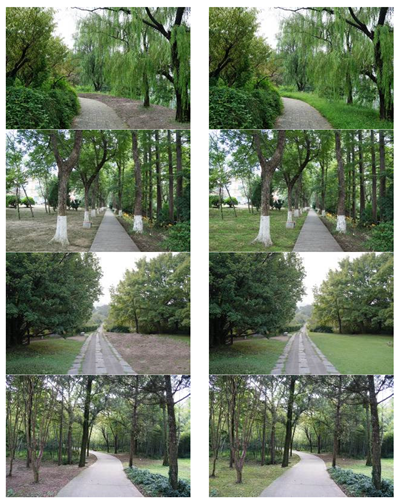 | 86.93 | 2.01 | 18.394 | <0.001 | |
| Pair 2 | 93.99 | 1.41 | 31.091 | <0.001 | ||
| Pair 3 | 92.58 | 1.56 | 27.280 | <0.001 | ||
| Pair 4 | 87.99 | 1.94 | 19.620 | <0.001 | ||
| Bench with Backs/ Arms | ||||||
| Pair 1 | 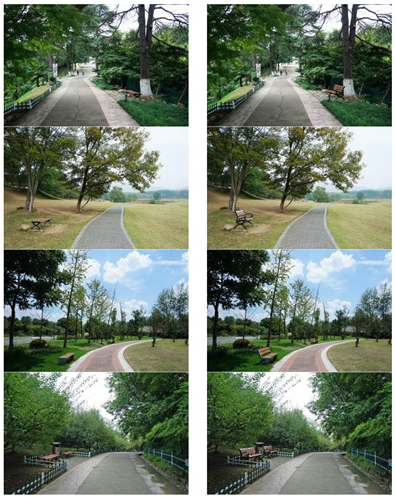 | 89.75 | 1.81 | 22.012 | <0.001 | |
| Pair 2 | 90.11 | 1.78 | 22.556 | <0.001 | ||
| Pair 3 | 88.69 | 1.89 | 20.518 | <0.001 | ||
| Pair 4 | 90.11 | 1.78 | 22.556 | <0.001 | ||
| Colorful Flowers | ||||||
| Pair 1 | 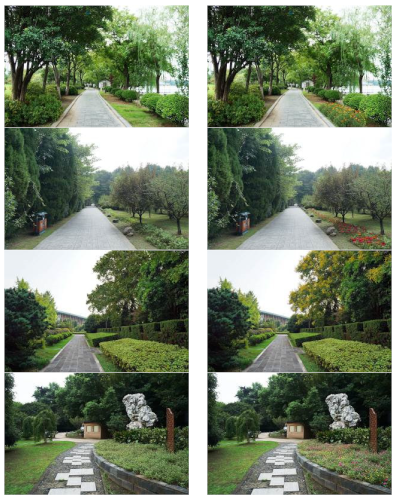 | 91.17 | 1.69 | 24.360 | <0.001 | |
| Pair 2 | 89.75 | 1.81 | 22.012 | <0.001 | ||
| Pair 3 | 83.04 | 2.23 | 14.784 | <0.001 | ||
| Pair 4 | 89.05 | 1.86 | 20.995 | <0.001 | ||
| Available Seating | ||||||
| Pair 1 | 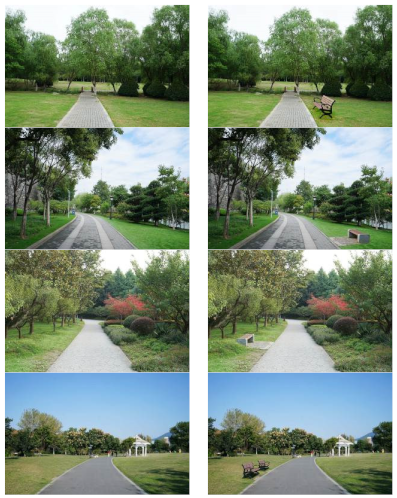 | 87.99 | 1.94 | 19.620 | <0.001 | |
| Pair 2 | 74.20 | 2.61 | 9.291 | <0.001 | ||
| Pair 3 | 78.09 | 2.46 | 11.405 | <0.001 | ||
| Pair 4 | 87.28 | 1.98 | 18.788 | <0.001 | ||
| Diverse Mix of Plants | ||||||
| Pair 1 | 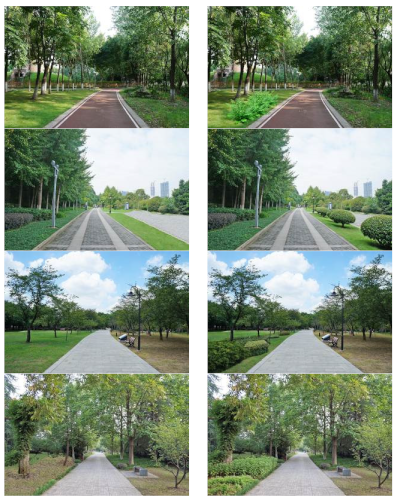 | 53.36 | 2.97 | 1.130 | 0.259 | |
| Pair 2 | 83.04 | 2.23 | 14.784 | <0.001 | ||
| Pair 3 | 65.02 | 2.84 | 5.288 | <0.001 | ||
| Pair 4 | 85.87 | 2.07 | 17.289 | <0.001 | ||
| Visual Accessibility | ||||||
| Pair 1 |  | 68.20 | 2.77 | 6.562 | <0.001 | |
| Pair 2 | 60.07 | 2.92 | 3.453 | 0.001 | ||
| Pair 3 | 92.23 | 1.59 | 26.483 | <0.001 | ||
| Pair 4 | 55.48 | 2.96 | 1.851 | 0.065 | ||
| Canopy Trees | ||||||
| Pair 1 | 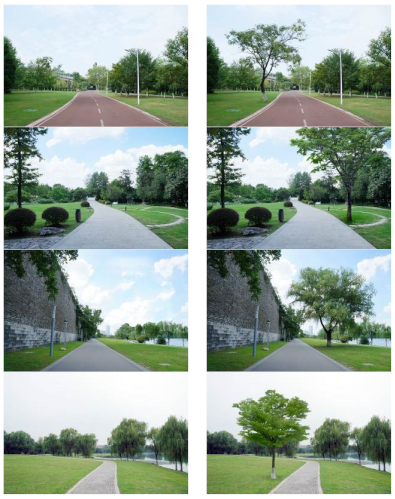 | 65.02 | 2.84 | 5.288 | <0.001 | |
| Pair 2 | 69.26 | 2.75 | 7.009 | <0.001 | ||
| Pair 3 | 66.78 | 2.80 | 5.984 | <0.001 | ||
| Pair 4 | 68.55 | 2.76 | 6.709 | <0.001 | ||
References
- Kemperman, A.; Timmermans, H. Green spaces in the direct living environment and social contacts of the aging population. Landsc. Urban Plan. 2014, 129, 44–54. [Google Scholar] [CrossRef]
- Gong, F.; Zheng, Z.-C.; Ng, E. Modeling Elderly Accessibility to Urban Green Space in High Density Cities: A Case Study of Hong Kong. Procedia Environ. Sci. 2016, 36, 90–97. [Google Scholar] [CrossRef]
- Pleson, E.; Nieuwendyk, L.M.; Lee, K.K.; Chaddah, A.; Nykiforuk, C.I.J.; Schopflocher, D. Understanding Older Adults’ Usage of Community Green Spaces in Taipei, Taiwan. Int. J. Environ. Res. Public Health 2014, 11, 1444–1464. [Google Scholar] [CrossRef] [PubMed]
- Tu, H.; Liao, X.; Schuller, K.; Cook, A.; Fan, S.; Lan, G.; Lu, Y.; Yuan, Z.; Moore, J.B.; Maddock, J.E. Insights from an observational assessment of park-based physical activity in Nanchang, China. Prev. Med. Rep. 2015, 2, 930–934. [Google Scholar] [CrossRef] [PubMed]
- Wang, X. Study of Health Outcomes Evaluation and Design Guidelines for Urban Parks. Ph.D. Thesis, Tongji University, Shanghai, China, 2017. submitted. [Google Scholar]
- Haber, D. Health Promotion and Aging: Practical Applications for Health Professionals, 7th ed.; Springer Publishing Company: New York, NY, USA, 2016. [Google Scholar]
- Gonzalez, M.T.; Kirkevold, M. Benefits of sensory garden and horticultural activities in dementia care: A modified scoping review. J. Clin. Nurs. 2014, 23, 2698–2715. [Google Scholar] [CrossRef] [PubMed]
- Kim, S.-Y.; Kim, D.-I. Association of regular walking and body mass index on metabolic syndrome among an elderly Korean population. Exp. Gerontol. 2018, 106, 178–182. [Google Scholar] [CrossRef]
- Cohen-Mansfield, J.; Marx, M.S.; Guralnik, J.M. Motivators and Barriers to Exercise in an Older Community-Dwelling Population. J. Aging Phys. Act. 2003, 11, 242–253. [Google Scholar] [CrossRef]
- Peschardt, K.K.; Stigsdotter, U.K.; Schipperrijn, J. Identifying Features of Pocket Parks that May Be Related to Health Promoting Use. Landsc. Res. 2016, 41, 79–94. [Google Scholar] [CrossRef]
- Wang, X.; Rodiek, S.; Wu, C.; Chen, Y.; Li, Y. Stress recovery and restorative effects of viewing different urban park scenes in Shanghai, China. Urban For. Urban Green. 2016, 15, 112–122. [Google Scholar] [CrossRef]
- Shi, S.L.; Tong, C.M.; Cooper Marcus, C. What makes a garden in the elderly care facility well used? Landsc. Res. 2019, 44, 256–269. [Google Scholar] [CrossRef]
- Arnberger, A.; Allex, B.; Eder, R.; Ebenberger, M.; Wanka, A.; Kolland, F.; Wallner, P.; Hutter, H.-P. Elderly resident’s uses of and preferences for urban green spaces during heat periods. Urban For. Urban Green. 2017, 21, 102–115. [Google Scholar] [CrossRef]
- Alves, S.M.; Gulwadi, G.B.; Cohen, U. Accommodating Culturally Meaningful Activities in Outdoor Settings for Older Adults. J. Hous. Elder. 2006, 19, 109–140. [Google Scholar] [CrossRef]
- Zhai, Y.; Baran, P.K. Do configurational attributes matter in context of urban parks? Park pathway configurational attributes and senior walking. Landsc. Urban Plan. 2016, 148, 188–202. [Google Scholar] [CrossRef]
- Zhai, Y.; Baran, P.K. Urban park pathway design characteristics and senior walking behavior. Urban For. Urban Green. 2017, 21, 60–73. [Google Scholar] [CrossRef]
- Duan, Y.; Wagner, P.; Zhang, R.; Wulff, H.; Brehm, W. Physical activity areas in urban parks and their use by the elderly from two cities in China and Germany. Landsc. Urban Plan. 2018, 178, 261–269. [Google Scholar] [CrossRef]
- King, W.C.; Belle, S.H.; Brach, J.S.; Simkin-Silverman, L.R.; Soska, T.; Kriska, A.M. Objective Measures of Neighborhood Environment and Physical Activity in Older Women. Am. J. Prev. Med. 2005, 28, 461–469. [Google Scholar] [CrossRef] [PubMed]
- Curl, A.; Thompson, C.W.; Aspinall, P. The effectiveness of ‘shared space’ residential street interventions on self-reported activity levels and quality of life for older people. Landsc. Urban Plan. 2015, 139, 117–125. [Google Scholar] [CrossRef]
- Yung, E.H.K.; Ho, W.K.O.; Chan, E.H.W. Elderly satisfaction with planning and design of public parks in high density old districts: An ordered logit model. Landsc. Urban Plan. 2017, 165, 39–53. [Google Scholar] [CrossRef]
- Sugiyama, T.; Thompson, C.W. Associations between characteristics of neighbourhood open space and older people’s walking. Urban For. Urban Green. 2008, 7, 41–51. [Google Scholar] [CrossRef]
- Wen, C.; Albert, C.; Von Haaren, C. The elderly in green spaces: Exploring requirements and preferences concerning nature-based recreation. Sustain. Cities Soc. 2018, 38, 582–593. [Google Scholar] [CrossRef]
- Alves, S.; Aspinall, P.A.; Ward Thompson, C.; Sugiyama, T.; Brice, R.; Vickers, A. Preferences of older people for environmental attributes of local parks: The use of choice-based conjoint analysis. Facilities 2008, 26, 433–453. [Google Scholar] [CrossRef]
- Gibson, S.C. “Let’s go to the park.” An investigation of older adults in Australia and their motivations for park visitation. Landsc. Urban Plan. 2018, 180, 234–246. [Google Scholar] [CrossRef]
- Robbins, P.; Birkenholtz, T. Turfgrass revolution: Measuring the expansion of the American lawn. Land Use Policy 2003, 20, 181–194. [Google Scholar] [CrossRef]
- Cooper Marcus, C.C. Alzheimer’s Garden Audit Tool. J. Hous. Elder. 2007, 21, 179–191. [Google Scholar] [CrossRef]
- Ignatieva, M.; Eriksson, F.; Eriksson, T.; Berg, P.; Hedblom, M. The lawn as a social and cultural phenomenon in Sweden. Urban For. Urban Green. 2017, 21, 213–223. [Google Scholar] [CrossRef]
- Rodiek, S.D.; Fried, J.T. Access to the outdoors: Using photographic comparison to assess preferences of assisted living residents. Landsc. Urban Plan. 2005, 73, 184–199. [Google Scholar] [CrossRef]
- Rodiek, S. Resident Perceptions of Physical Environment Features that Influence Outdoor Usage at Assisted Living Facilities. J. Hous. Elder. 2006, 19, 95–107. [Google Scholar] [CrossRef]
- Bengtsson, A.; Carlsson, G. Outdoor Environments at Three Nursing Homes. J. Hous. Elder. 2006, 19, 49–69. [Google Scholar] [CrossRef]
- Chalfont, G.E.; Rodiek, S. Building edge: An ecological approach to research and design of environments for people with dementia. Alzheimer’s Care Q. Environ. Innov. Care 2005, 6, 341–348. [Google Scholar]
- Cooper Marcus, C.; Sachs, N.A. Therapeutic Landscapes: An Evidence-Based Approach to Designing Healing Gardens and Restorative Outdoor Spaces; John Wiley & Sons: Hoboken, NJ, USA, 2013. [Google Scholar]
- Marcus, C.C. Garden of the Family Life Center, Grand Rapids, Michigan. J. Hous. Elder. 2007, 21, 285–304. [Google Scholar] [CrossRef]
- Rodiek, S. Access to Nature for Older Adults [Educational Video Series]. Available from Center for Health Systems & Design, College of Architecture, Texas A & M University, College Station, TX 77843. Available online: www.accesstonature.org (accessed on 16 December 2018).
- Rodiek, S.; Nejati, A.; Bardenhagen, E.; Lee, C.; Senes, G. The Seniors’ Outdoor Survey: An Observational Tool for Assessing Outdoor Environments at Long-Term Care Settings. Gerontologist 2016, 56, 222–233. [Google Scholar] [CrossRef] [PubMed]
- Kearney, A.R.; Winterbottom, D. Nearby Nature and Long-Term Care Facility Residents. J. Hous. Elder. 2006, 19, 7–28. [Google Scholar] [CrossRef]
- Rappe, E.; Topo, P. Contact with Outdoor Greenery Can Support Competence Among People with Dementia. J. Hous. Elder. 2007, 21, 229–248. [Google Scholar] [CrossRef]
- Ottosson, J.; Grahn, P. Measures of restoration in geriatric care residents: The influence of nature on elderly peoples’ power of concentration, blood pressure and pulse rate. In The Role of the Outdoors in Residential Environments for Aging; Rodiek, S., Schwarz, B., Eds.; The Haworth Press, Inc.: New York, NY, USA, 2006. [Google Scholar]
- Appleton, J. The Experience of Landscape; John Wiley and Sons: New York, NY, USA, 1975. [Google Scholar]
- Ulrich, R.S.; Simons, R.F.; Losito, B.D.; Fiorito, E.; Miles, M.A.; Zelson, M. Stress recovery during exposure to natural and urban environments. J. Environ. Psychol. 1991, 11, 201–230. [Google Scholar] [CrossRef]
- Cohenmansfield, J. Outdoor Wandering Parks for Persons with Dementia. J. Hous. Elder. 2007, 21, 35–53. [Google Scholar] [CrossRef]
- Cranz, G.; Young, C. The Role of Design in Inhibiting or Promoting Use of Common Open Space. J. Hous. Elder. 2006, 19, 71–93. [Google Scholar] [CrossRef]
- Orians, G.H. An ecological and evolutionary approach to landscape aesthetics. In Landscape Meanings and Values; Penning-Rowsell, E.C., Lowenthal, D., Eds.; Allen and Unwin: London, UK, 1986. [Google Scholar]
- Lohr, V.I.; Pearson-Mims, C.H. Responses to Scenes with Spreading, Rounded, and Conical Tree Forms. Environ. Behav. 2006, 38, 667–688. [Google Scholar] [CrossRef]
- Cooper Marcus, C.; Barnes, M. Gardens in Healthcare Facilities: Uses, Therapeutic Benefits, and Design Recommendations; Center for Health Design: Martinez, CA, USA, 1995. [Google Scholar]
- Regnier, V. Design for Assisted living: Guidelines for Housing the Physically and Mentally Frail; John Wiley & Sons: New York, NY, USA, 2002. [Google Scholar]
- Zeisel, J. Creating a Therapeutic Garden That Works for People Living with Alzheimer’s. J. Hous. Elder. 2007, 21, 13–33. [Google Scholar] [CrossRef]
- Zeisel, J. Improving person-centered care through effective design. Generations 2013, 37, 45–52. [Google Scholar]
- Cutler, L.J.; Kane, R.A. As Great as All Outdoors. J. Hous. Elder. 2006, 19, 29–48. [Google Scholar] [CrossRef]
- Krogstad, J.R.; Hjorthol, R.; Tennøy, A. Improving walking conditions for older adults. A three-step method investigation. Eur. J. Ageing 2015, 12, 249–260. [Google Scholar] [CrossRef] [PubMed]
- Cooper Marcus, C.; Barnes, M. Healing Gardens: Therapeutic Benefits and Design Recommendations; John Wiley & Sons: New York, NY, USA, 1999. [Google Scholar]
- Dolecka, U.E.; Ownsworth, T.; Kuys, S.S. Comparison of sit-to-stand strategies used by older adults and people living with dementia. Arch. Gerontol. Geriatr. 2015, 60, 528–534. [Google Scholar] [CrossRef] [PubMed]
- Bengtsson, A.; Carlsson, G. Outdoor environments at three nursing homes-qualitative interviews with residents and next of kin. Urban For. Urban Green. 2013, 12, 393–400. [Google Scholar] [CrossRef]
- Scopelliti, M.; Giuliani, M.V. Restorative Environments in Later Life. J. Hous. Elder. 2006, 19, 203–226. [Google Scholar] [CrossRef]
- Jim, C.; Chen, S.S. Comprehensive greenspace planning based on landscape ecology principles in compact Nanjing city, China. Landsc. Urban Plan. 2003, 65, 95–116. [Google Scholar] [CrossRef]
- Bureau of Statistics of Nanjing. All Residents per Capita Disposable Income. Available online: http://221.226.86.104/_s3/658/list.psp (accessed on 21 April 2019).
- Bureau of Statistics of Nanjing; Survey Office of National Bureau of Statistics in Naning. Nanjing Statistical Yearbook; China Statistics Press: Beijing, China, 2017. [Google Scholar]
- Dupont, L.; Ooms, K.; Antrop, M.; Van Etvelde, V. Testing the validity of a saliency-based method for visual assessment of constructions in the landscape. Landsc. Urban Plan. 2017, 167, 325–338. [Google Scholar] [CrossRef]
- Palmer, J.F. The perceived scenic effects of clearcutting in the White Mountains of New Hampshire, USA. J. Environ. Manag. 2008, 89, 167–183. [Google Scholar] [CrossRef]
- Tress, B.; Tress, G. Scenario visualisation for participatory landscape planning—A study from Denmark. Landsc. Urban Plan. 2003, 64, 161–178. [Google Scholar] [CrossRef]
- Lee, M.-A.; Rodiek, S.D. Residents’ Preference for Spatial Features in Sitting Areas at Assisted Living Facilities—Focused on direct or indirect social interaction for older adults. Int. J. Hum. Ecol. 2013, 14, 87–102. [Google Scholar] [CrossRef]
- Nejati, A.; Rodiek, S.; Shepley, M. Using visual simulation to evaluate restorative qualities of access to nature in hospital staff break areas. Landsc. Urban Plan. 2016, 148, 132–138. [Google Scholar] [CrossRef]
- Brawley, E.C. Design Innovations for Aging and Alzheimer’s: Creating Caring Environments; Wiley: Hoboken, NJ, USA, 2005. [Google Scholar]
- Carstens, D.Y. Site Planning and Design for the Elderly: Issues, Guidelines, and Alternatives; Van Nostrand Reinhold: New York, NY, USA, 1985. [Google Scholar]
- Sloane, P.D.; Mitchell, C.M.; Weisman, G.; Zimmerman, S.; Foley, K.M.L.; Lynn, M.; Calkins, M.; Lawton, M.P.; Teresi, J.; Grant, L.; et al. The Therapeutic Environment Screening Survey for Nursing Homes (TESS-NH): An Observational Instrument for Assessing the Physical Environment of Institutional Settings for Persons with Dementia. J. Gerontol. Ser. B 2002, 57, S69–S78. [Google Scholar] [CrossRef] [PubMed]
- Stoneham, J.; Thoday, P. Landscape Design for Elderly and Disabled People; Antique Collectors Club Ltd.: Woodbridge, VA, USA, 1996. [Google Scholar]
- Cassidy, P. The Illustrated Practical Guide to Gardening for Seniors; Lorenz Books: London, UK, 2011. [Google Scholar]
- Rodiek, S.; Lee, C. External space: Increasing outdoor usage in residential facilities for older adults. World Health Des. 2009, 2, 49–55. [Google Scholar]
- Abramov, I.; Gordon, J.; Feldman, O.; Chavarga, A. Sex & vision I: Spatio-temporal resolution. Biol. Sex. Differ. 2012, 3, 20. [Google Scholar] [PubMed]
- Abramov, I.; Gordon, J.; Feldman, O.; Chavarga, A. Sex and vision II: Color appearance of monochromatic lights. Biol. Sex. Differ. 2012, 3, 21. [Google Scholar] [CrossRef] [PubMed]
- Kaplan, S.; Kaplan, R. The Experience of Nature: A Psychological Perspective; Cambridge University Press: New York, NY, USA, 1989. [Google Scholar]
- White, M.; Smith, A.; Humphryes, K.; Pahl, S.; Snelling, D.; Depledge, M. Blue space: The importance of water for preference, affect, and restorativeness ratings of natural and built scenes. J. Environ. Psychol. 2010, 30, 482–493. [Google Scholar] [CrossRef]
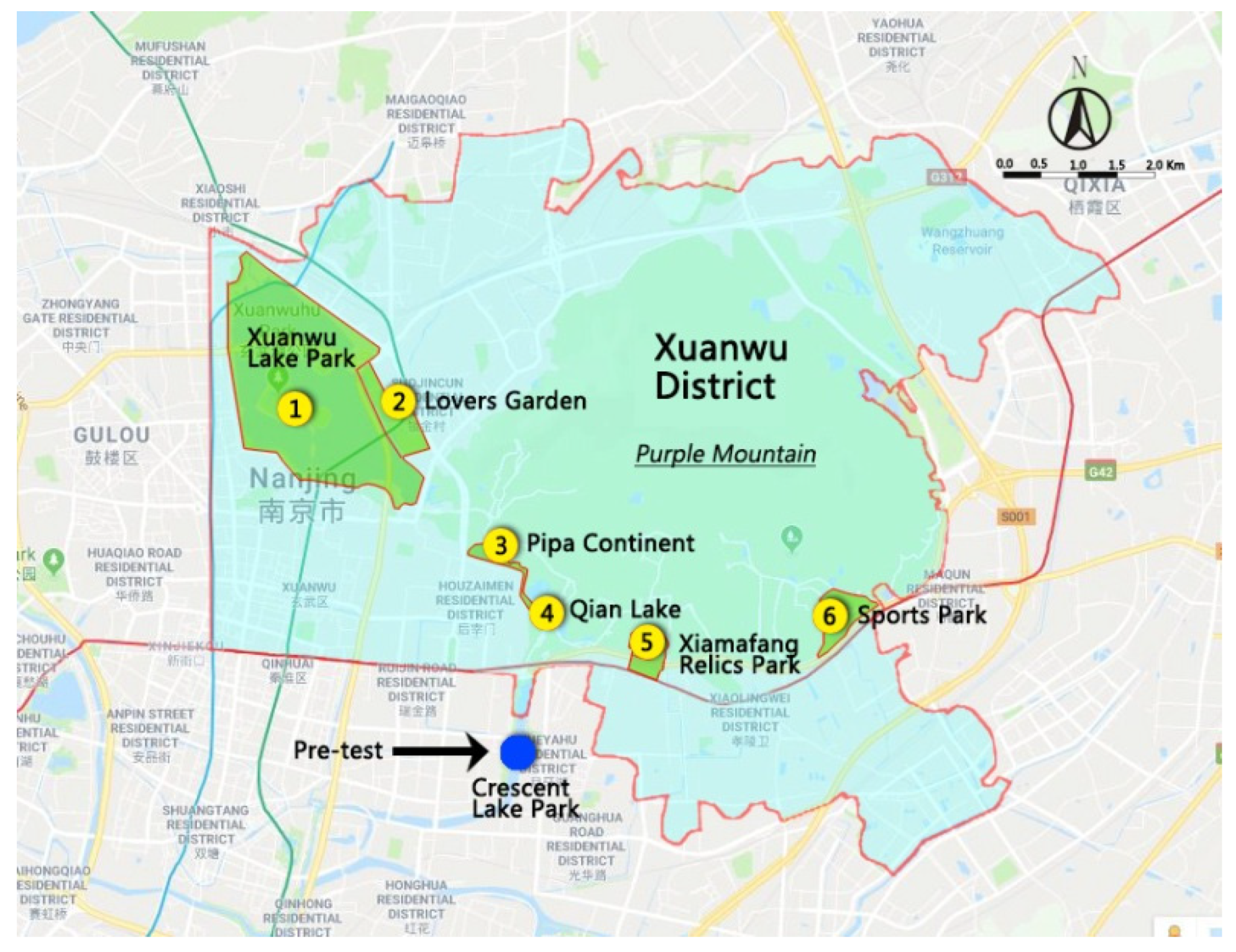
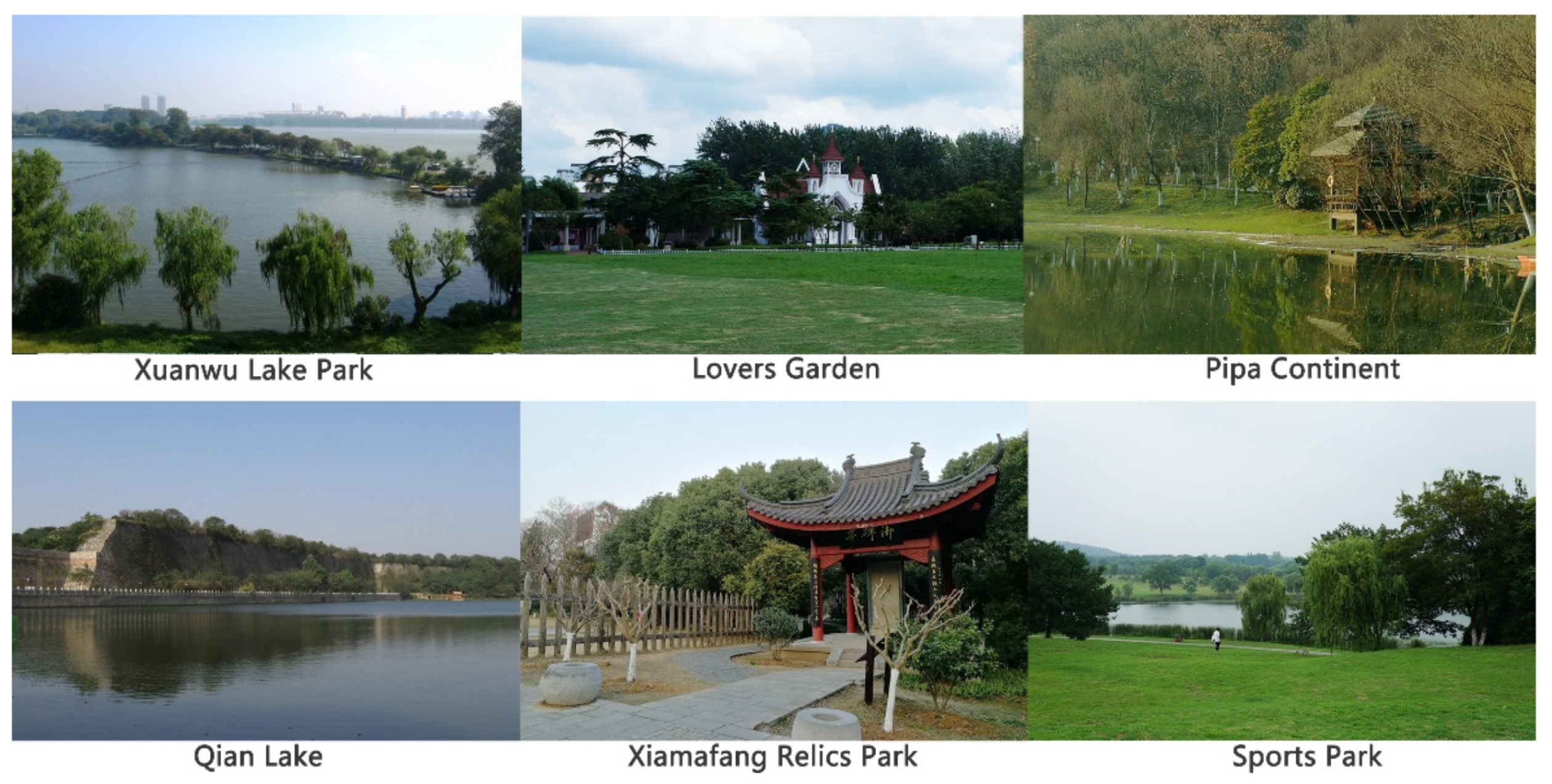
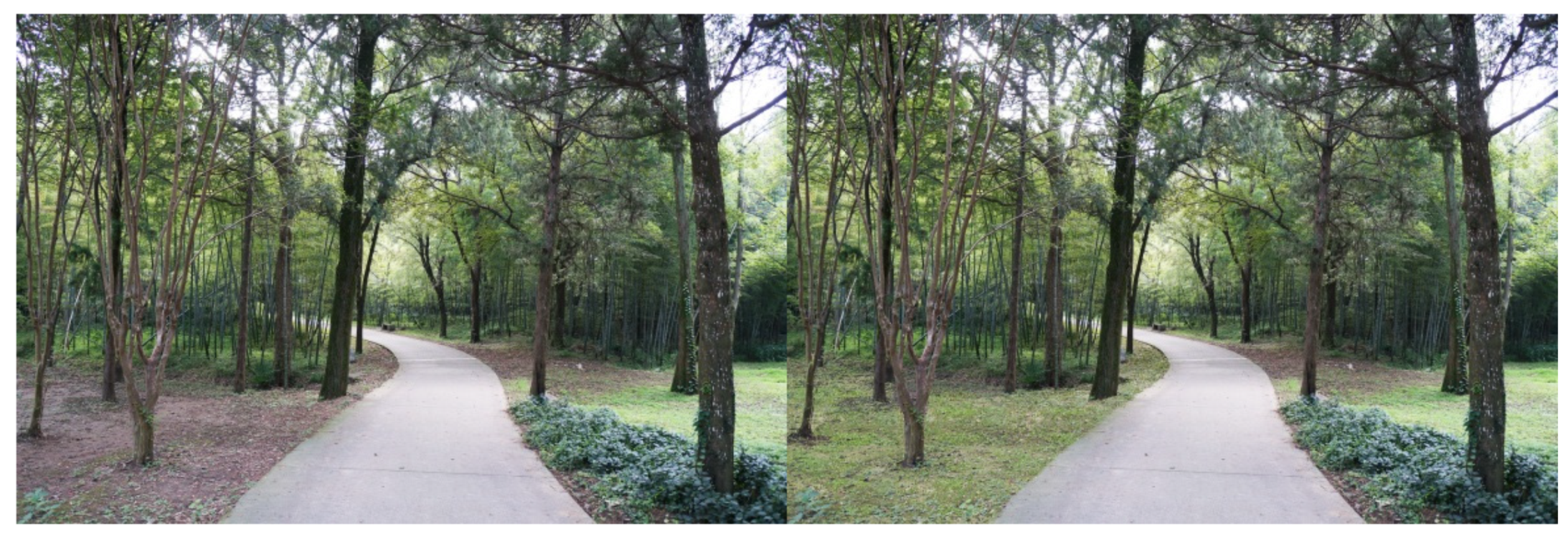
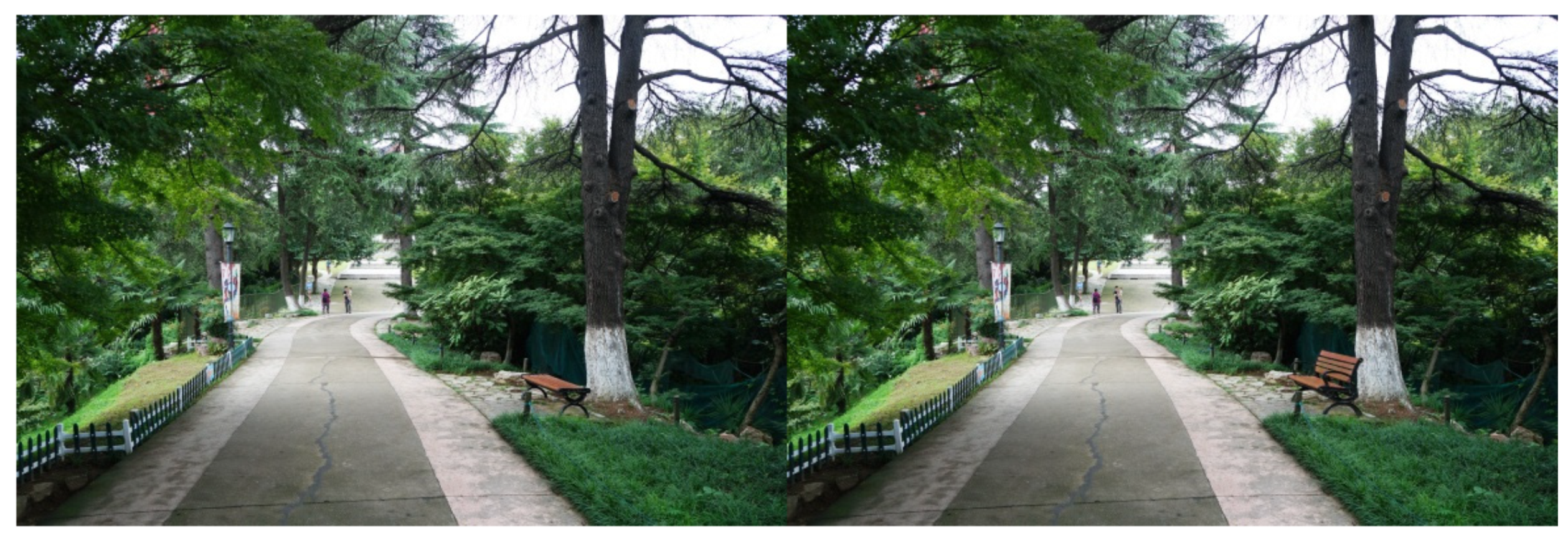
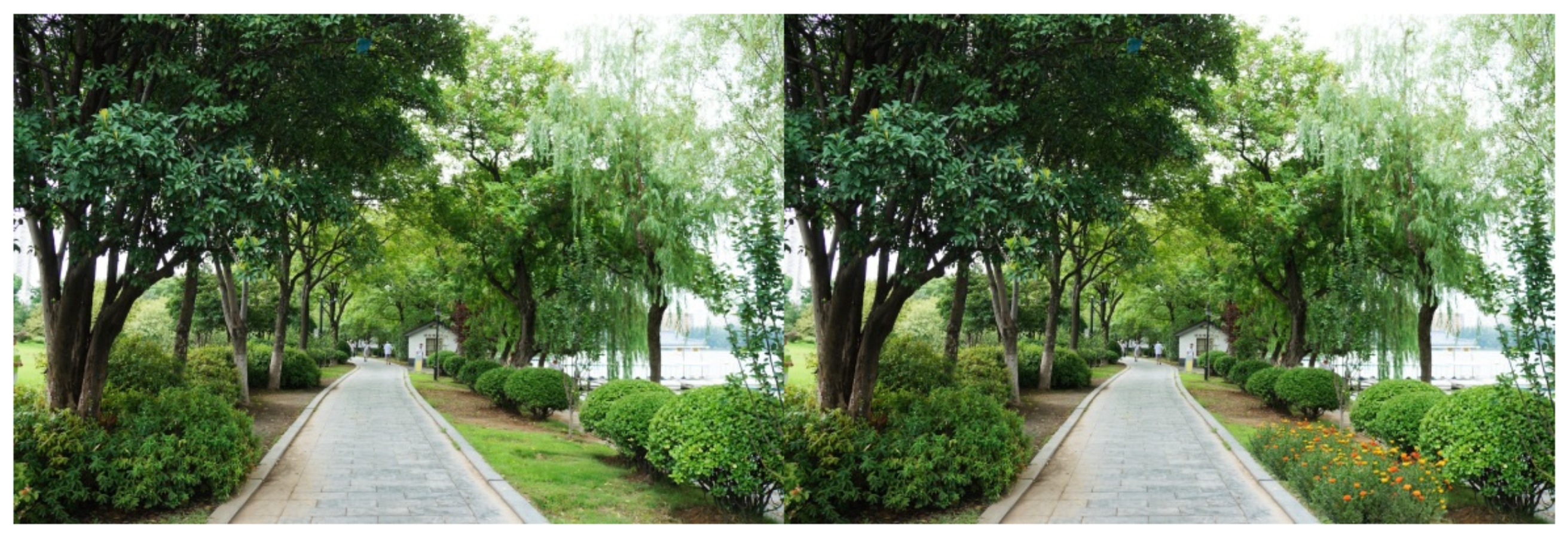
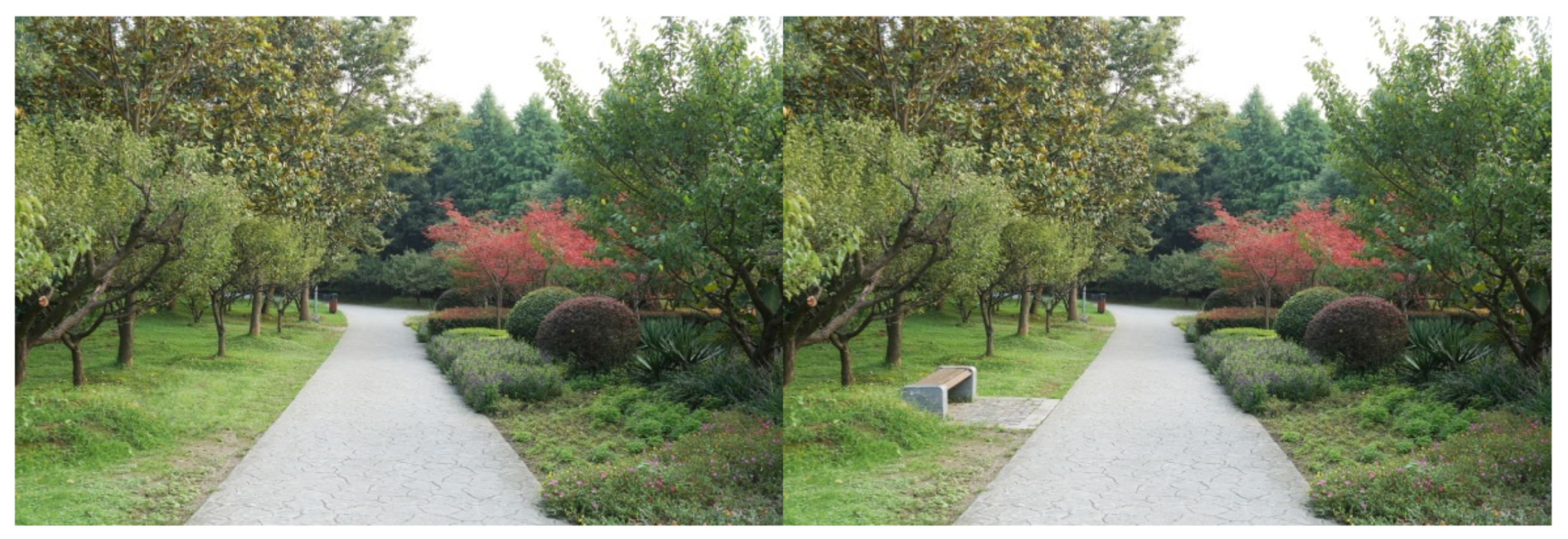
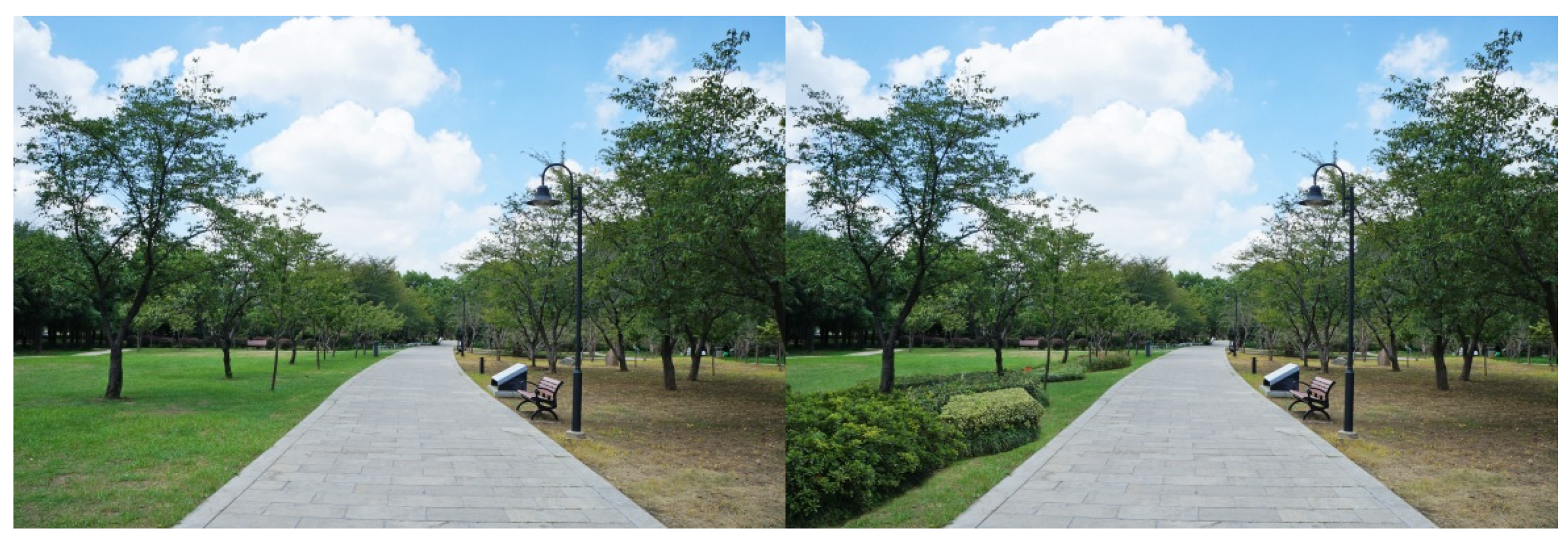
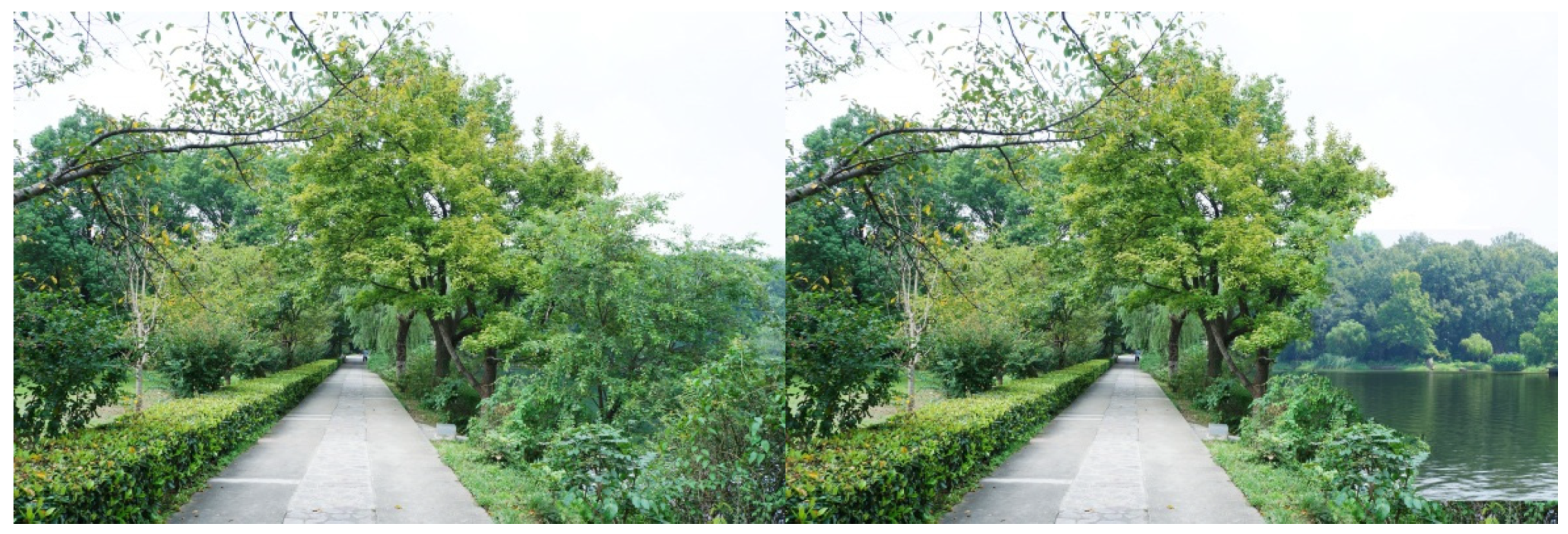
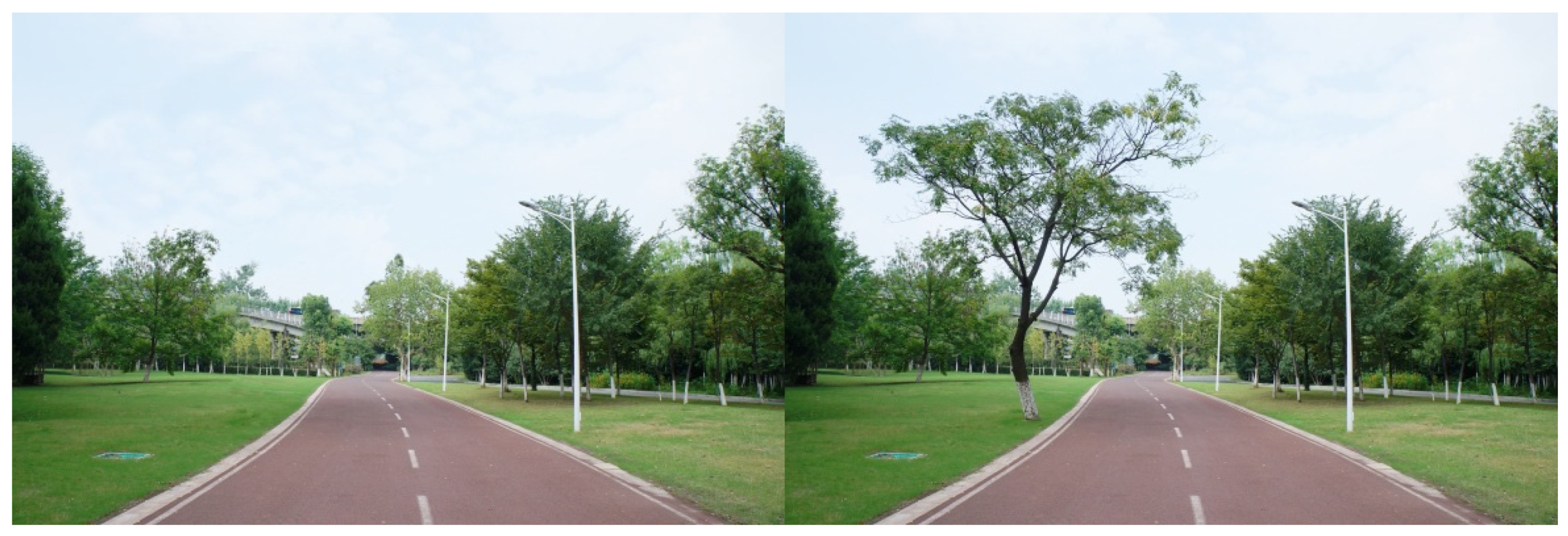
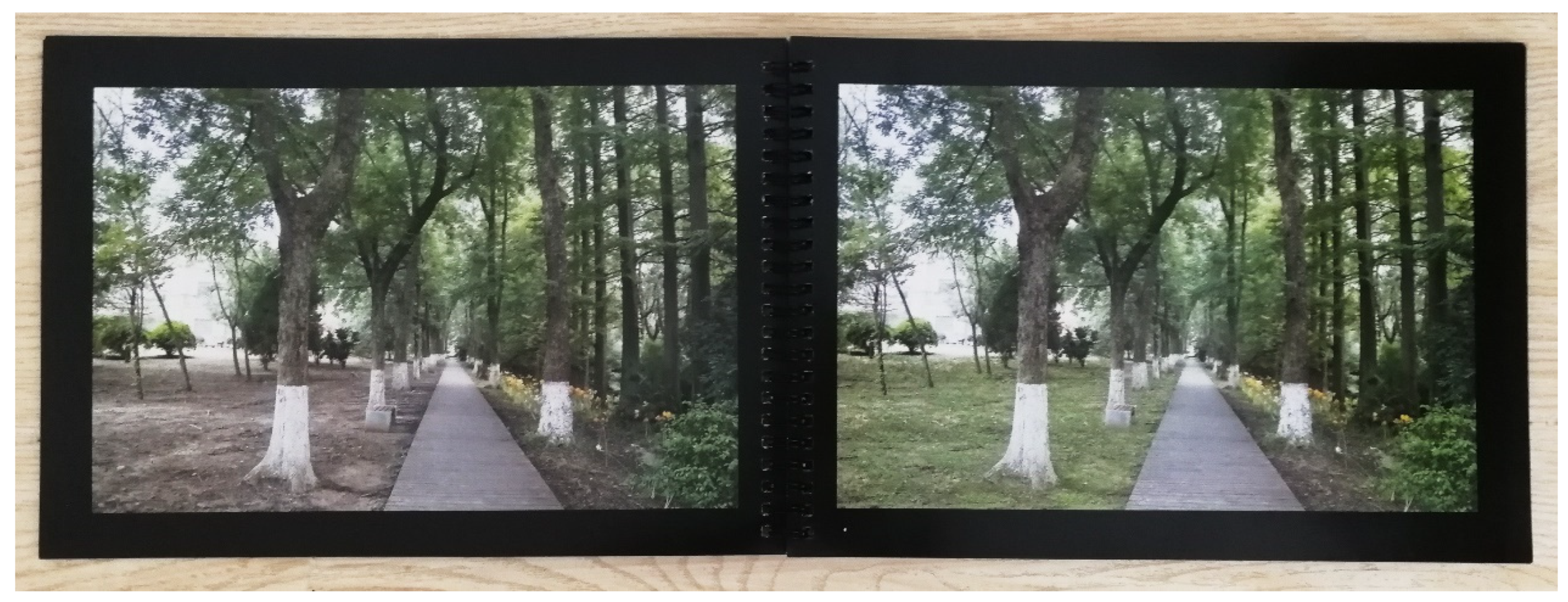
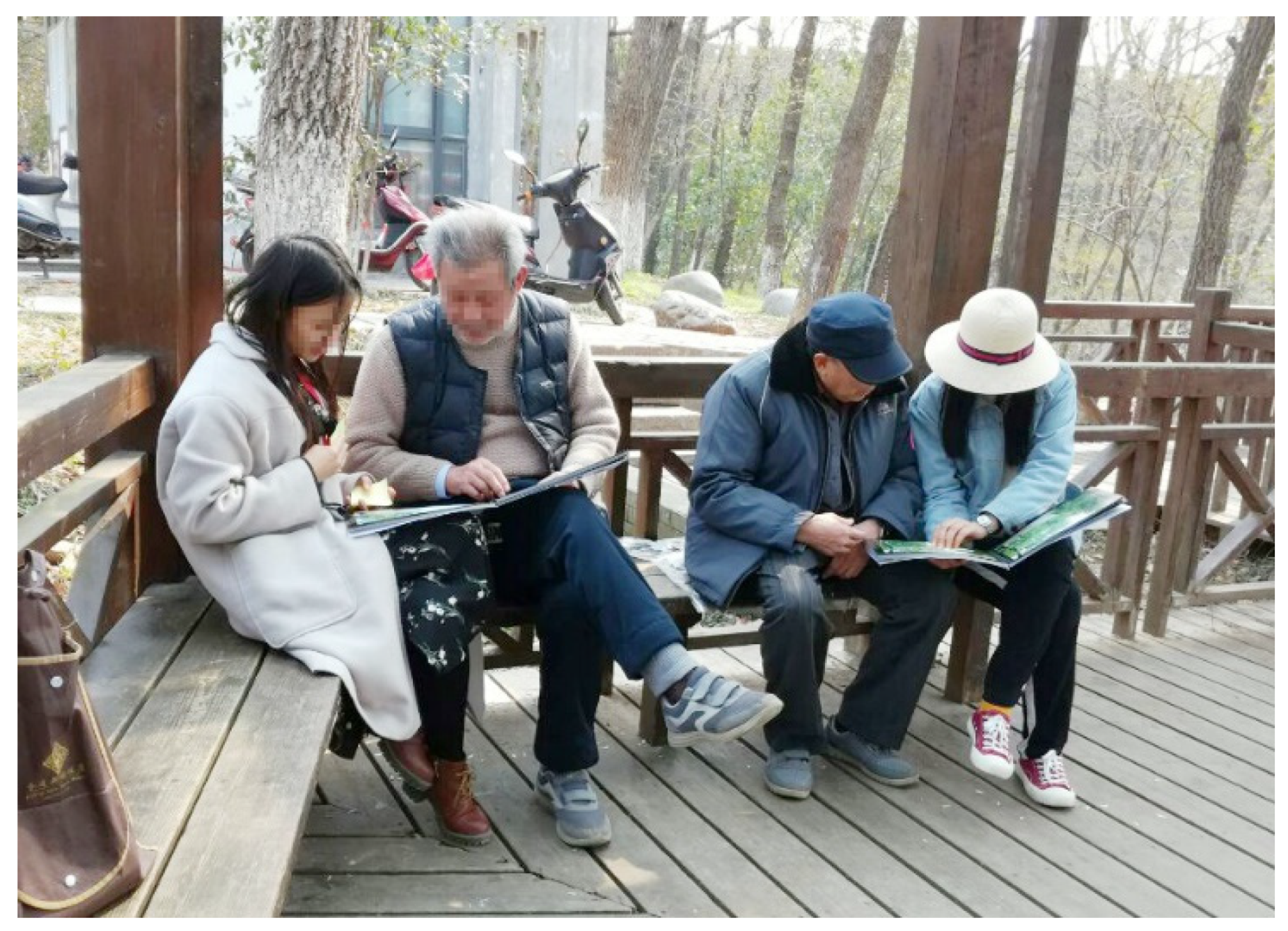
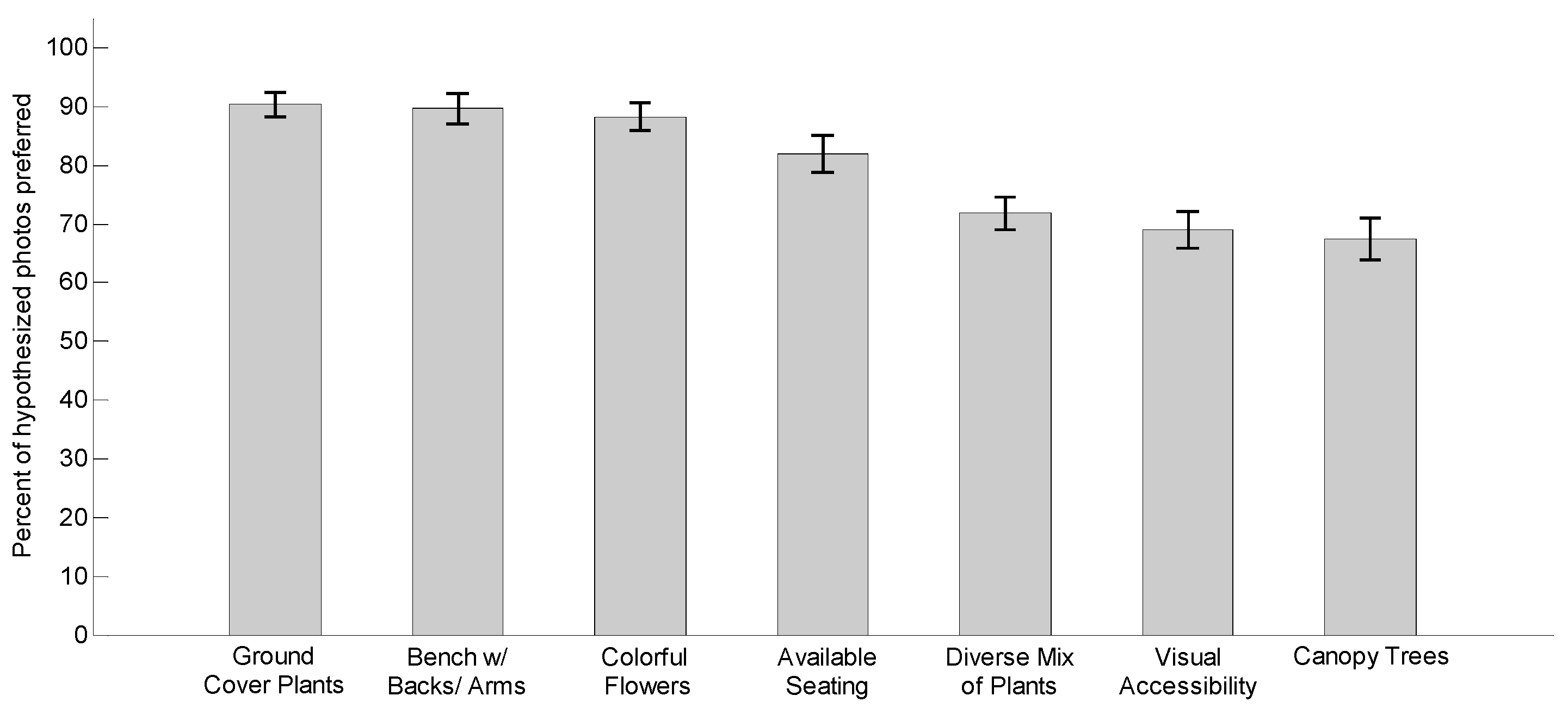
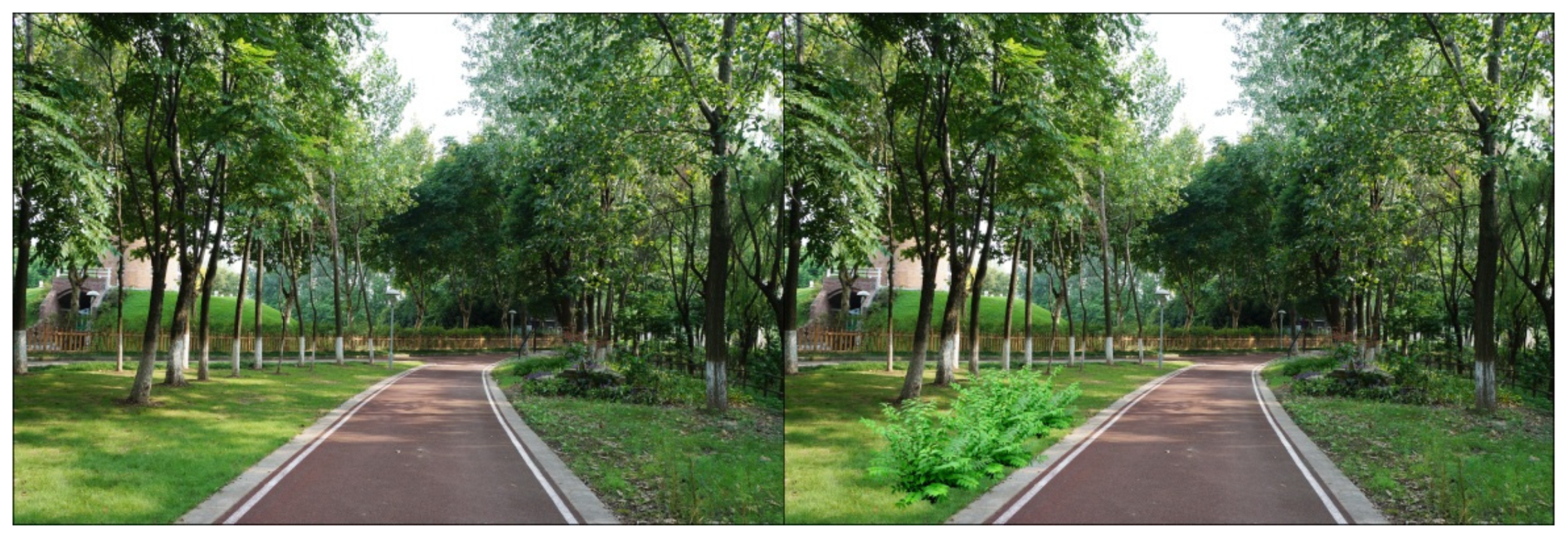
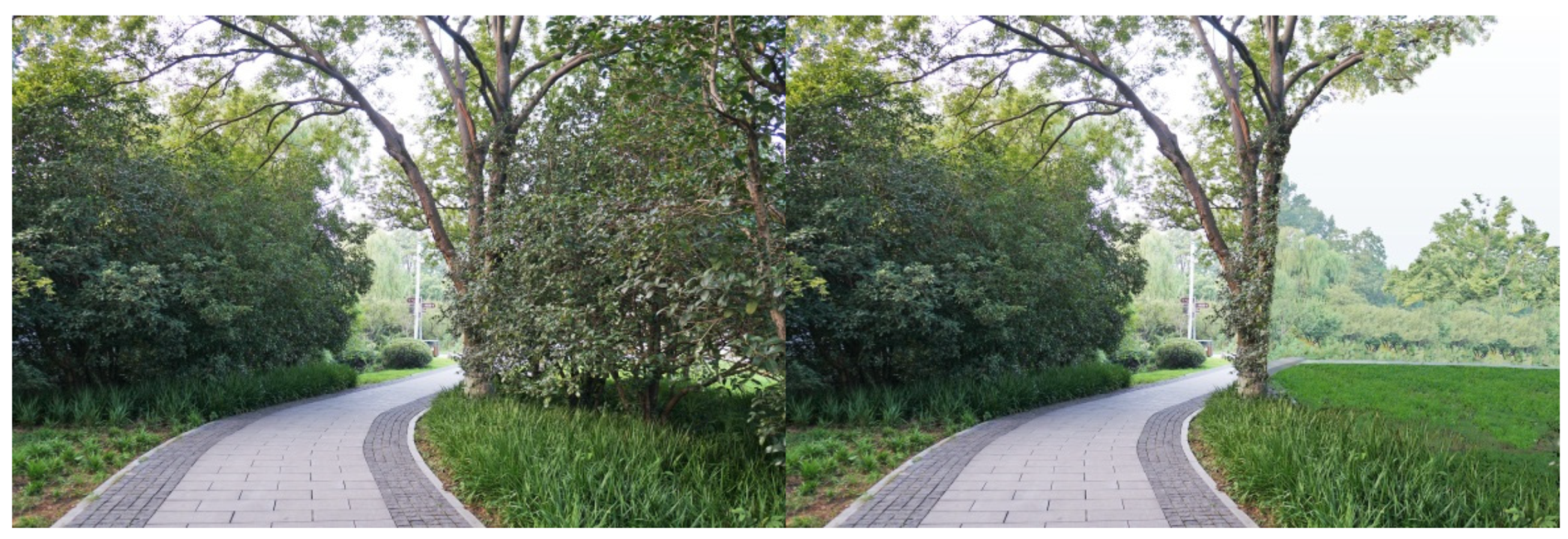
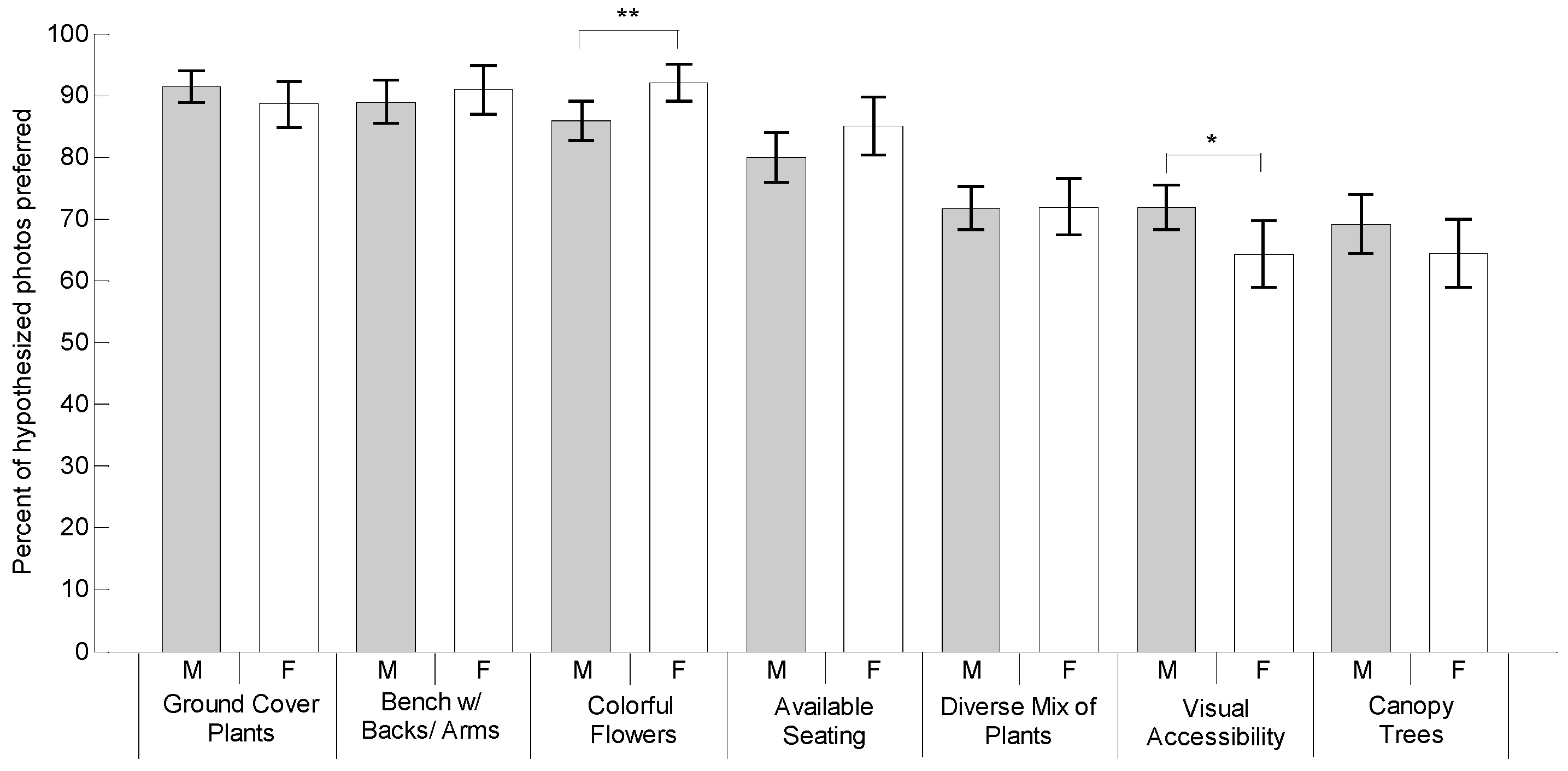
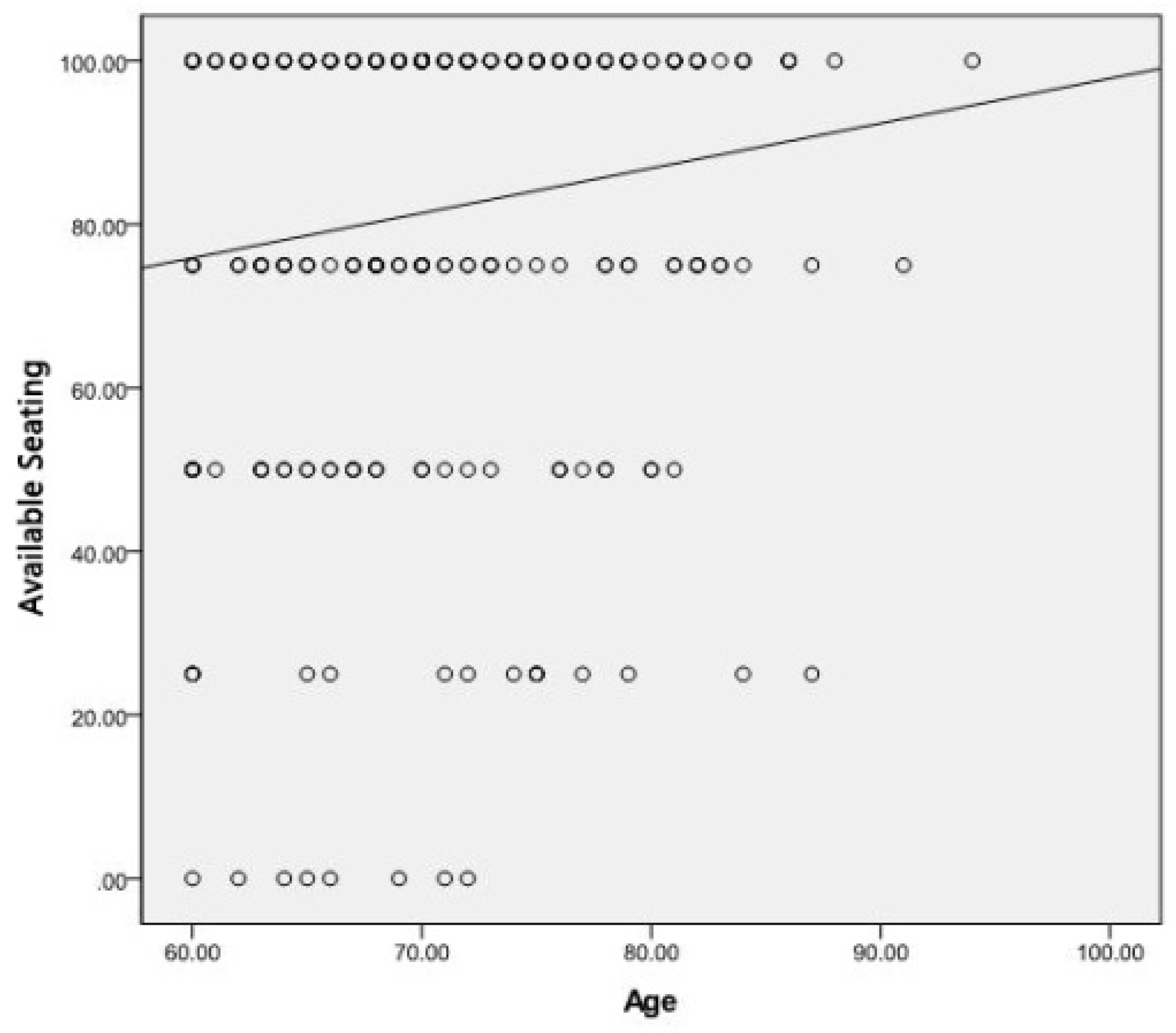
| Urban Parks | Mean Age | Number and % of Participants | Males | Females |
|---|---|---|---|---|
| Xuanwu Lake Park | 71.22 (6.68) | 95 (33.57%) | 65 (68.42%) | 30 (31.58%) |
| Lovers Garden | 71.57 (6.56) | 51 (18.02%) | 30 (58.82%) | 21 (41.18%) |
| Pipa Continent | 70.10 (7.53) | 41 (14.49%) | 25 (60.98%) | 16 (39.02%) |
| Qian Lake | 70.70 (7.68) | 37 (13.07%) | 19 (51.35%) | 18 (48.65%) |
| Xiamafang Relics Park | 70.47 (6.83) | 32 (11.31%) | 18 (56.25%) | 14 (43.75%) |
| Sports Park | 70.85 (6.52) | 27 (9.54%) | 19 (56.25%) | 8 (43.75%) |
| Total | 70.93 (6.88) | 283 (100%) | 176 (62.19%) | 107 (37.81%) |
| 95% Confidence Interval for Mean | |||||
|---|---|---|---|---|---|
| Landscape Features | Mean | Lower | Upper | Std. Error of Mean | t |
| Ground Cover Plants | 90.37 | 88.24 | 92.50 | 1.08 | 37.37 *** |
| Bench w/ Backs/ Arms | 89.66 | 87.05 | 92.28 | 1.33 | 29.91 *** |
| Colorful Flowers | 88.25 | 85.92 | 90.58 | 1.18 | 32.35 *** |
| Available Seating | 81.89 | 78.82 | 84.96 | 1.56 | 20.45 *** |
| Diverse Mix of Plants | 71.82 | 69.07 | 74.57 | 1.40 | 15.61 *** |
| Visual Accessibility | 68.99 | 65.91 | 72.08 | 1.57 | 12.12 *** |
| Canopy Trees | 67.40 | 63.77 | 71.03 | 1.84 | 9.44 *** |
| Landscape Features | Ground Cover Plants | Bench with Backs and Arms | Color Flowers | Available Seating | Diverse Mix of Plants | Visual Accessibility | Canopy Trees |
|---|---|---|---|---|---|---|---|
| Ground cover Plants | - | 0.71 (0.642) | 2.12 (0.159) | 8.48 (<0.001) | 18.55 (<0.001) | 21.38 (<0.001) | 22.97 (<0.001) |
| Bench with backs/arms | - | - | 1.41 (0.360) | 7.77 (<0.001) | 17.84 (<0.001) | 20.67 (<0.001) | 22.26 (<0.001) |
| Colorful flowers | - | - | - | 6.36 (0.001) | 16.43 (<0.001) | 19.26 (<0.001) | 20.85 (<0.001) |
| Available seating | - | - | - | - | 10.07 (<0.001) | 12.90 (<0.001) | 14.49 (<0.001) |
| Diverse mix of plants | - | - | - | - | - | 2.83 (0.220) | 4.42 (0.024) |
| Visual accessibility | - | - | - | - | - | - | 1.59 (0.557) |
| Canopy Trees | - | - | - | - | - | - | - |
| Landscape Features | Mean Difference | Std. Error Difference | t | p |
|---|---|---|---|---|
| Ground Cover Plants | 2.93 | 2.31 | 1.2682 | 0.2062 |
| Bench with Backs/Arms | −1.97 | 2.74 | −0.7187 | 0.4729 |
| Colorful Flowers | −6.12 | 2.25 | −2.7241 | 0.0069 ** |
| Available Seating | −5.08 | 3.21 | −1.5824 | 0.1147 |
| Diverse Mix of Plants | −0.23 | 2.89 | −0.0795 | 0.9367 |
| Visual Accessibility | 7.62 | 3.31 | 2.3002 | 0.0225 * |
| Canopy Trees | 4.69 | 3.80 | 1.2350 | 0.2179 |
© 2019 by the authors. Licensee MDPI, Basel, Switzerland. This article is an open access article distributed under the terms and conditions of the Creative Commons Attribution (CC BY) license (http://creativecommons.org/licenses/by/4.0/).
Share and Cite
Wang, X.; Rodiek, S. Older Adults’ Preference for Landscape Features Along Urban Park Walkways in Nanjing, China. Int. J. Environ. Res. Public Health 2019, 16, 3808. https://doi.org/10.3390/ijerph16203808
Wang X, Rodiek S. Older Adults’ Preference for Landscape Features Along Urban Park Walkways in Nanjing, China. International Journal of Environmental Research and Public Health. 2019; 16(20):3808. https://doi.org/10.3390/ijerph16203808
Chicago/Turabian StyleWang, Xinxin, and Susan Rodiek. 2019. "Older Adults’ Preference for Landscape Features Along Urban Park Walkways in Nanjing, China" International Journal of Environmental Research and Public Health 16, no. 20: 3808. https://doi.org/10.3390/ijerph16203808
APA StyleWang, X., & Rodiek, S. (2019). Older Adults’ Preference for Landscape Features Along Urban Park Walkways in Nanjing, China. International Journal of Environmental Research and Public Health, 16(20), 3808. https://doi.org/10.3390/ijerph16203808




